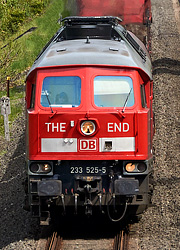GOING ROUND IN CIRCLES
Diverted Freights in the Oberpfalz
Germany - 25 April to 12 May 2016 - Report by Duncan Cotterill
INTRODUCTION
The temporary closure of the electrified main line north of Bamberg and the diversion of freights via the diesel worked Hof - Marktredwitz - Nürnberg route provided the excuse I needed for another trip to these photogenic lines in north-eastern Bavaria. As well as Ludmillas on main line freights, class 294s were seen on china clay traffic on the Amberg - Hirschau branch and a few locos belonging to independents appeared as well. Passenger trains weren’t ignored entirely with the ALEX class 223s photographed between Weiden and Hof. Time was also spent capturing the soon to disappear class 143s on the Reichenbach - Hof line and class 111s and 183s between Regensburg and Landshut.This page contains the main report summarising the trip. Detailed daily observations can be found here.
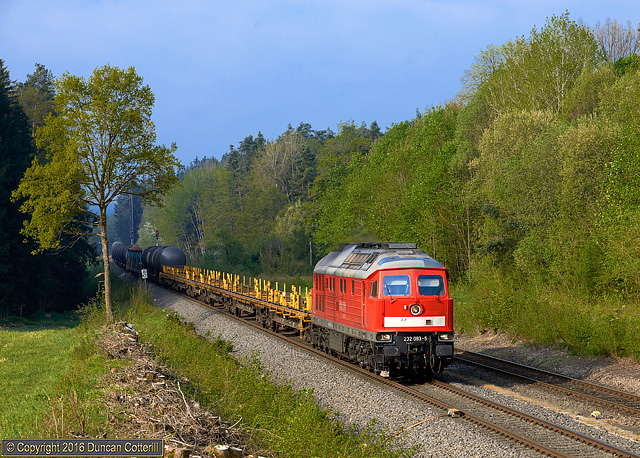
Red Versus Green
The red livery of 232.093 provided a contrast to the brilliant greens of Spring as the Ludmilla held the main at Großalbershof in glorious morning light on 11 May 2016. Northbound freight EZ 51721 was one of many diverted to run from Nürnberg to Hof via Weiden with diesel haulage during the temporary closure of the Bamberg - LIchtenfels route, which will continue until early September.These scenic lines don’t normally see much goods traffic so the opportunity to photograph big diesels on heavy freights was too good to miss.
HOF - NÜRNBERG FREIGHT DIVERSIONS
26 - 30 April, 2 - 7 & 9 - 12 May 2016Engineering work in conjunction with the new Bamberg - Erfurt high speed line requires the closure of the electrified Bamberg - Lichtenfels line from 12 January to 3 September 2016. With no suitable electrified diversionary route available, many freights are diverted via Hof and Marktredwitz to Nürnberg with diesel haulage. Most northbound trains take the southern (links Pegnitz) line from Nürnberg, through Hersbruck, to Neukirchen then head north-east to Weiden and north through Marktredwitz to Hof. Southbounds also use the Hof - Marktredwitz line but then take the more direct route via Kirchenlaibach and Pegnitz to Hersbruck and the northern (rechts Pegnitz) line to Nürnberg.
The lines in question have lost a lot of their normal freight traffic over the past few years, leaving only a couple of daily trains from Nürnberg to Cheb and back via Marktredwitz and a daily freight from Nürnberg to Schwandorf and back via Neukirchen. There are also some block trains running once or twice a week, usually on an as required basis, as well as the occasional special or one-off working. Independent operators’ locos do appear on some irregular workings but the vast majority of trains are worked by DB Cargo using class 232 and 233 diesels.
The addition of the diverted freights has brought traffic levels up to about six trains each way in daylight on Tuesdays to Fridays with almost as many on Saturdays. Sundays and Mondays are very quiet, which is why I went elsewhere on those days. With the one-way system in operation, most places would only see the trains going in one direction or the other. For this year, the Nürnberg - Cheb freights also use the one-way system, northbound via Weiden and southbound via Kirchenlaibach, but the Schwandorf trains continue to run via Neukirchen in both directions.
The vast majority of diverted trains were worked by DB Cargo class 232s or 233s, mostly single locos but a few pairs. It appeared that the double heading was down to saving light engine movements and on most occasions it was clear that the second loco wasn’t doing any work.
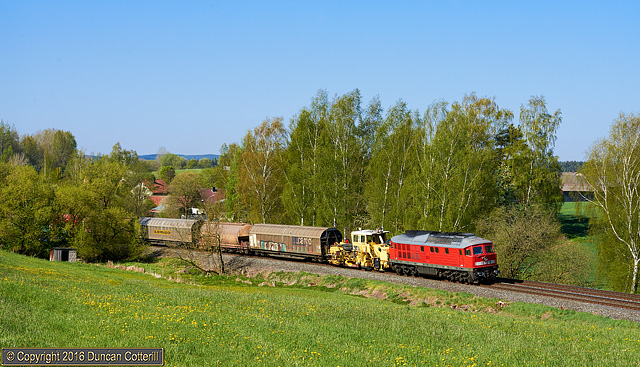
Location Location Location
Railway photography is as much about the location as the motive power and finding good spots can sometimes be a challenge. Fortunately the diesel lines north and east of Nürnberg are well endowed with attractive locations. This spot at Escheldorf, north of Reuth (bei Erbendorf) was one of many discovered during the trip.233.219 headed north with EZ 51721 on the morning of 7 May 2016, the second of three freights to pass in 80 minutes, all northbounds.
The official timings for freights are fairly slack and most trains seemed to run early. An hour or so ahead of schedule was not unusual. Of 55 freights that could be identified, just over half were at least 30 minutes early and, of these, 13 were at least an hour early and 3 of them 90 - 100 minutes early. There were only 13 trains within 10 minutes of right time and only three of these were late. Nothing was noted more than 10 minutes late.
About 75% of the freights expected were actually seen. Of the others, around half were probably missed because they ran very early and the other half most likely didn’t run. In some cases a light engine indicated this and in others I was in sight of the line for a couple of hours either side of when they were due and saw nothing. Mixed freights, those with EK or EZ prefixes, formed the vast majority of the booked workings and tended to be much more reliable than block trains (GA or GB prefixes). Of eight expected block trains, only two were actually seen.
About 75% of the freights expected were actually seen. Of the others, around half were probably missed because they ran very early and the other half most likely didn’t run. In some cases a light engine indicated this and in others I was in sight of the line for a couple of hours either side of when they were due and saw nothing. Mixed freights, those with EK or EZ prefixes, formed the vast majority of the booked workings and tended to be much more reliable than block trains (GA or GB prefixes). Of eight expected block trains, only two were actually seen.
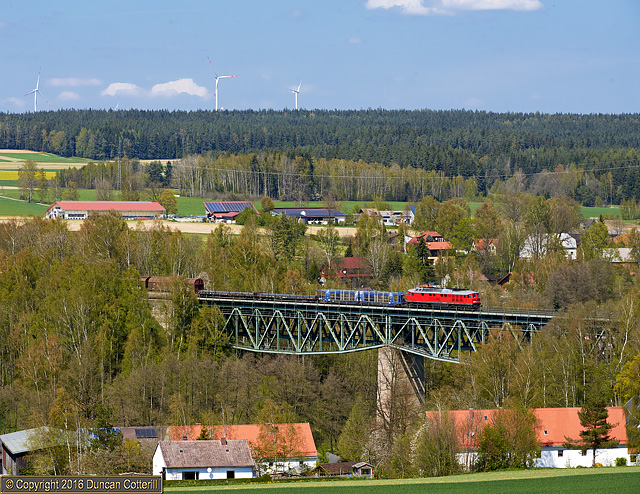
Better Late Than Never
A continuing theme of the trip was early running with some trains passing as much as 100 minutes before they were due. That made southbound freight EZ 51081 unusual in running a few minutes late on 6 May 2016. 232.609 was photographed crossing Thölau Viaduct in the early afternoon.The other freight expected to run that lunchtime hadn’t appeared and late running was so unusual that I’d virtually given up on EZ 51081 when it emerged from the woods just to the north of the viaduct. The bridge is 3 km north of Marktredwitz and dates from the late 1870s when the direct line from Wiesau to Oberkotzau was built by the Bayerische Staats-Eisenbahn.
There are also a number of trip freights linking customers to the yards at Marktredwitz and Schwandorf, booked for DB Cargo class 294s. I was in position to see the afternoon trip from Marktredwitz to Wiesau and back on three separate occasions but it was a no-show each time. A Schwandorf - Regensburg trip was seen on the last day with the expected 294.
DB Cargo locos seen:
232.093, 232.209, 232.252, 232.262, 232.330, 232.569, 232.571, 232.609, 232.618, 232.703
233.040, 233.112, 233.127, 233.176, 233.219, 233.306, 233.322, 233.367, 233.373, 233.525, 233.636, 233.662, 233.698
294.795
Of the 23 Ludmillas, 233.040, 233.662 and 233.698 were used on last year’s Marschbahn freight diversions.
DB Cargo locos seen:
232.093, 232.209, 232.252, 232.262, 232.330, 232.569, 232.571, 232.609, 232.618, 232.703
233.040, 233.112, 233.127, 233.176, 233.219, 233.306, 233.322, 233.367, 233.373, 233.525, 233.636, 233.662, 233.698
294.795
Of the 23 Ludmillas, 233.040, 233.662 and 233.698 were used on last year’s Marschbahn freight diversions.
White Goods
223.143 passed Groschlattengrün, north of Pechbrunn with a northbound container train on the afternoon of 6 May 2016.This train doesn’t appear in the timetable but it was seen on four separate occasions during the trip, twice behind the white 223 and twice north of Hof behind an SBBC class 482. Similar containers were seen in the industrial site adjacent to Wiesau station and it appears that the train is a regular working from there to Hamburg.
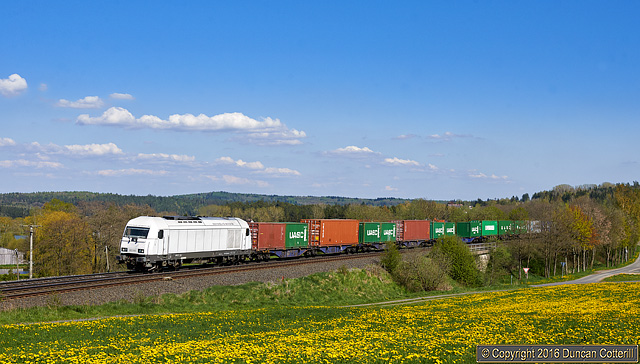
In addition to the DB Cargo trains, a number of freights were seen with independent operators’ locos. It was difficult to see a regular pattern in most workings and many appeared to be one-off moves of track machines or construction equipment. One traffic flow that showed some sort of regularity was a northbound container train that was seen on a couple of afternoons on the Weiden - Marktredwitz and Marktredwitz - Hof sections, hauled by “nordic rail service.de” loco 223.143. The same train was seen north of Hof on a couple of occasions behind an SBB Cargo class 482 electric (see below). Further research indicates that this is a daily working from Wiesau to Hamburg and Bremerhaven although timings seemed to vary by several hours from day to day. The only other train that appeared more than once was a southbound steel train that passed Hof around 17:00 on 2 and 3 May with Stahlwerke Thüringen locos, a pair of ex DR V100s one day and a Traxx DE the next.
Other operators’ locos seen:
D-BBL : 214.023, 214.026
D-BEBRA : 275.120, 277.003
D-DGT : 293.009, 293.011
D-ELOC : 193.247 (dit)
D-FME : 52.8195
D-PRESS : 140.810 (dit), 202.565, 203.211, 203.215
D-SG : 223.143
D-SGL : 293.507
D-STOCK : 264.001
D-SWT : 203.003, 203.013
A-RTS : 2016.907
B-SWT : 76.111
Other operators’ locos seen:
D-BBL : 214.023, 214.026
D-BEBRA : 275.120, 277.003
D-DGT : 293.009, 293.011
D-ELOC : 193.247 (dit)
D-FME : 52.8195
D-PRESS : 140.810 (dit), 202.565, 203.211, 203.215
D-SG : 223.143
D-SGL : 293.507
D-STOCK : 264.001
D-SWT : 203.003, 203.013
A-RTS : 2016.907
B-SWT : 76.111
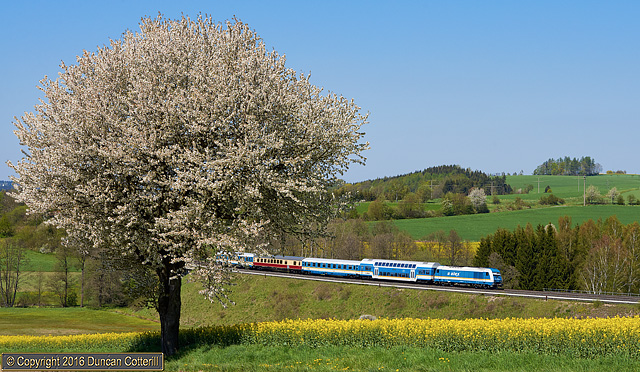
ALEX in the Landscape
The Bavarian landscape comes alive in late April and early May, making this my favourite time to photograph trains in southern Germany. A red Ludmilla would have looked good here but there was a good chance the wagons would have blended into the background, making it look like a light engine. ALEX came to the rescue as it often did.223.069 climbed away from Oberkotzau with ALX84115, the 13:40 from Hof to München, on 7 May 2016.
Passenger Services
Most passenger services on the lines in question are operated by DMUs. The only exceptions are the ALEX services between München and Hof that are diesel hauled north of Regensburg. These trains run at approximately two-hourly intervals with a four hour gap in the middle of the afternoon, partially filled by additional Friday and Sunday trains. Class 223 EuroRunner diesels in ALEX’s blue, white and yellow colours are used and haul trains in both directions, a nice change from the push-pull working that’s the norm on regional services elsewhere. The fleet of 12 class 223s is shared with ALEX’s other operation between München and Lindau / Oberstdorf and seven different locos were seen in use. There is some interchange of locos between the two operations; 223.072 was seen on an Oberstdorf service on 25 April but had transferred to the Hof route a week later.
ALEX locos seen:
D-VBG : 223.062, 223.063, 223.065, 223.066, 223.068, 223.069, 223.072
On Time Appearance
223.063 accelerated away from Wiesau with ALX84109, the 07:40 from Hof to München, on 6 May 2016, passing the fish ponds south of town.With all the uncertainty surrounding the timing of freight workings, it was useful to have some loco hauled trains that could be relied on to show up when they were expected. Timekeeping wasn’t perfect but most ALEX trains ran within a few minutes of right time, including this one.
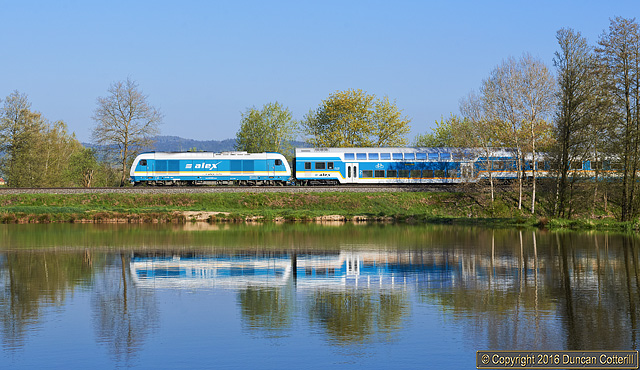
A variety of DMUs can be seen on other passenger services. DB operate RegioExpress services between Nürnberg and Bayreuth, Hof, Cheb, Neustadt (Waldnaab) and Schwandorf using 2-car tilting class 612 DMUs. These trains often split or combine en-route and can be made up of anywhere between 1 and 4 sets. They can also be found on the occasional RE service between Hof and Regensburg or between Schwandorf and Furth im Wald and more frequently between Schwandorf and Regensburg. Stopping passengers between Nürnberg and Neuhaus (Pegnitz) are operated by DB with 2-car articulated class 648 units.
Elsewhere stopping passengers are the responsibility of other operators. Agilis use class 650 single units on the Kirchenlaibach - Marktredwitz - Hof route and some other lines nearby. Local passengers between Regensburg and Marktredwitz are the responsibility of the Oberpfalzbahn, a sister company of ALEX within the Netinera group. These were all worked by Vogtlandbahn white and green class 642 articulated 2-car sets a few years ago but there are now yellow and blue class 648 articulated 2-car sets and silver and blue 2-car class 622s as well.
Elsewhere stopping passengers are the responsibility of other operators. Agilis use class 650 single units on the Kirchenlaibach - Marktredwitz - Hof route and some other lines nearby. Local passengers between Regensburg and Marktredwitz are the responsibility of the Oberpfalzbahn, a sister company of ALEX within the Netinera group. These were all worked by Vogtlandbahn white and green class 642 articulated 2-car sets a few years ago but there are now yellow and blue class 648 articulated 2-car sets and silver and blue 2-car class 622s as well.
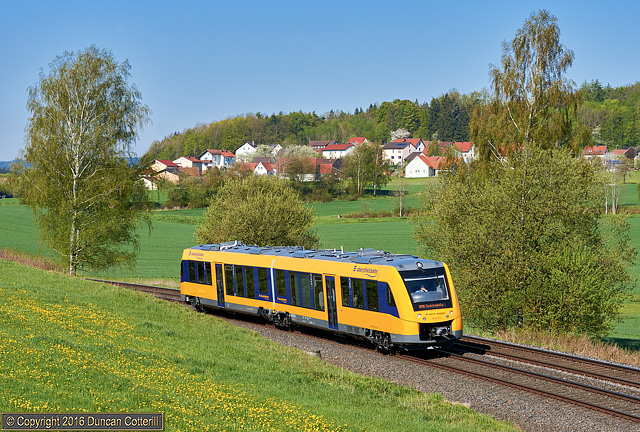
Paint It Yellow
If I’ve got to photograph multiple units then I’d prefer them to be painted in nice colours. The Oberpfalzbahn’s new class 648 units in yellow and blue make a pleasant shot if you can find a location where a short DMU doesn’t look lost in the landscape.1648.202 passed Escheldorf, north of Reuth (bei Erbendorf) while working OPB 79714, the 07:57 Regensburg - Marktredwitz stopping service on 7 May 2016. The numbering of these units in the 1648 series, rather than as 648s shows an unhealthy slide towards Great Westernism and must be stopped!.
Photography
Even with the diverted freights, the lines visited couldn’t be described as busy and the one-way system meant that it was difficult not to miss around half the day’s trains. Traffic in both directions was heaviest in the morning so it wasn’t even possible to swap between lines during the day and catch each of them at their busiest. On the average weekday I managed to see around four or five scheduled freights and often an ad-hoc working with an independents’ loco. There were plenty of occasions when I waited for hours at a spot only to leave empty handed because nothing showed up or the light died at the wrong moment. The weather wasn’t perfect either and the best light was over a five day period when traffic was reduced due to a national public holiday and a weekend. In short, photographing the freights was hard work but ultimately quite rewarding. At least the locations were very attractive so that when when you did get a train in good light, it produced a very nice picture.
The ALEX trains on the Regensburg line were very welcome. Eurorunners might not be everyone’s favourite engines but at least they’re engines and, after waiting for hours for something loco hauled, a lot better than yet another DMU.
Where’s The Pantograph?
Whenever I see a Traxx diesel, I can’t help wondering where the pantograph has gone. The external design of these locos is clearly based on the Traxx electrics (should that be electrixx?) of classes 145, 185 and 186. The latest version is the Traxx ME, with four small diesel engines instead of one big one, now in service with DB Regio and rapidly replacing the venerable class 218s.Class leader 245.001 worked RE 57510 west from Geltendorf at Schwabhausen on 25 April 2016. The 13:53 from München to Füssen was formed of double-deck stock, another recent change.
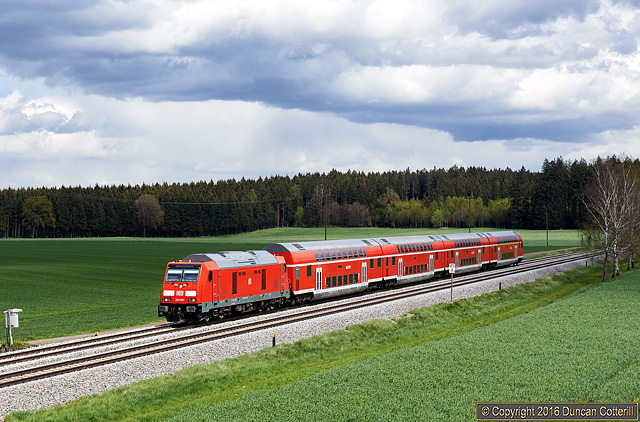
MÜNCHEN - BUCHLOE
25 April 2016This line was visited for a few hours around lunchtime on my first day in Germany. After getting up ridiculously early and flying to München, I wanted to go somewhere that would be fairly simple to get to and where I knew there were straightforward shots that wouldn’t require too much mental or physical effort on my part. I hadn’t counted on it still being winter in Germany with a blizzard to drive through on the way to Kaufering and a bitterly cold wind that made standing outside for any length of time uncomfortable. Remarkably, there were some good sunny spells between the snow showers and hailstorms and a few good shots were obtained on the Lechbrücke, east of Kaufering and at Schwabhausen, a few km further east.
Many of the class 218 turns to Memmingen and Füssen have gone over to class 245s since my last visit to the line in 2013 but a couple of Füssen trains were still 218 worked during my short visit. What had changed was the coaching stock with double-deck push-pull sets replacing the previous single deckers on all loco-hauled DB Regio trains, irrespective of whether 218 or 245 worked. The locos were at the west end of all trains seen. Several class 612 DMUs were also seen, all on München - Kempten trains. Both ECs seen were double headed 218s as expected.
A temporary timetable is in force until 20 October while the Immenstadt - Oberstaufen line is closed for engineering work. The usual ALEX services are only running to Oberstdorf and there are some loco hauled ALEX and DB Regio services to Lindau via Memmingen in addition to the usual München - Zürich ECs. Can I feel another trip coming on?
Locos seen :
218.423, 218.426, [EC]
218.411 [RE]
245.001, 245.005
D-VBG : 223.067, 223.072 [ALEX]
Run Rabbit Run
Despite the influx of class 245s, the most prestigious trains on the München - Buchloe line are still worked by pairs of class 218 diesels. Long may it continue!EC 194, the 12:33 München - Zürich EuroCity raced westwards behind 218.423 and 218.426 in glorious light on 25 April 2016.
Although the weather at Schwabhausen, 3km west of Geltendorf, looked pleasant, the cloud in the background had been pelting the area with hailstones until a few minutes earlier and the next one wasn’t far behind.
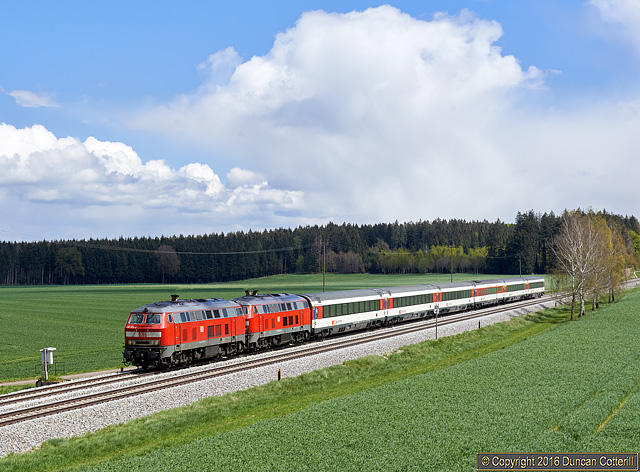
INGOLSTADT - TREUCHTLINGEN
25 - 26 April 2016Another short visit at the beginning of the trip with a couple of hours spent on the line through Altmühltal on the Monday afternoon and similar on the Tuesday morning. The weather was cold, dull and windy with frequent snow showers so I didn’t feel like hanging around any longer.
The hourly passenger service is still worked by class 111 electrics, always at the west end of push-pull sets, mainly formed of double-deck stock.
A total of nine freights were seen with classes 152, 182, 185 189 and 193 all being noted. Of the nine trains, only three were worked by DB Cargo locos with the rest hauled by independents.
The most interesting movement was of three light engines, brand new Vectrons on their way from München to their new owner, PKP Cargo.
Locos seen :
111.022, 111.065, 111.066, 111.148, 111.179, 111.187, 111.202
152.115, 185.169, 185.403
266.456 (dit)
D-HGK : 185.606
D-ELOC : 193.241
D-DISPO : 182.514, 182.595, 189.101, 189.151, 193.855
CH-SBBC : 482.036
PL-PKPC : 370.019, 370.021, 370.022
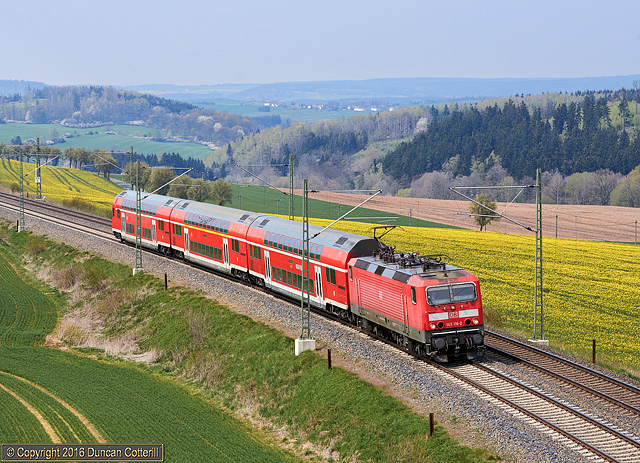
Back In The DDR
A quarter of a century after re-unification the former East Germany still feels different to the rest of the country. It’s not the railways so much as the landscape with its huge fields, inherited from the DDR’s collective farms, narrow, tree-lined, winding roads and old industrial buildings.143.116 rolled past a seemingly endless field of rape between Ruppertsgrün and Herlasgrün with RE 4789, the 12:27 Hof - Dresden RegioExpress, on 1 May 2016. A few years ago these services ran through from Nürnberg to Dresden but now passengers have to change at Hof on the old East - West border. Passport controls haven’t been re-introduced yet.
REICHENBACH - HOF
1 - 2 May 2016This was only my second visit to the Reichenbach - Hof line and the first one since the line was electrified. The class 143 electrics that have worked the hourly Dresden - Hof REs since late 2013 are due to be replaced by EMUs when DB hands over the franchise to an independent operator in June, so it was a last chance to get some pictures before loco haulage ends.
The line runs through an attractive hilly landscape with deeply incised river valleys, plenty of small villages and a few larger towns. Most of the countryside is given over to farming and forestry although there’s some industry as well. The line is unusual in sticking to the higher ground, resulting in a rather circuitous route with a couple of spectacular viaducts where it has to cross the Göltzsch and Elster river valleys. The Göltzschtalbrücke was being refurbished last time I was here and looks better now without all the scaffolding and plastic sheeting.
Fortunately the line has survived electrification well and most of the photo locations that were good in 2010 are still useable now. Although it’s over 25 years since reunification, much of the area still retains the look of the former DDR and is noticeably different to the Hof area, just a few km to the south in the former BRD.
On the first day all the REs were worked by 143s, always at the east end of a 3-car double-deck push-pull set, but on the second there was an interloper in the form of a pair of class 612 tilting DMUs that worked a couple of trains in each direction. Stopping passenger services were transferred to the Vogtlandbahn several years ago but are now split between Vogtlandbahn and Erfurter Bahn. Both companies use class 650 single units on their services.
Colourful Cargo
SBB Cargo’s wandering class 482s are always a welcome sight in their attractive large logo blue and red livery. However, most are actually on hire to various German independent operators and rarely visit Switzerland.482.041 approached Grobau, between Hof and Plauen, with a northbound container train on the afternoon of 2 May 2016
This is probably the daily working from the Ziegler container terminal in Wiesau to the docks in Hamburg seen behind the white 223 south of Hof on a couple of occasions the following week.
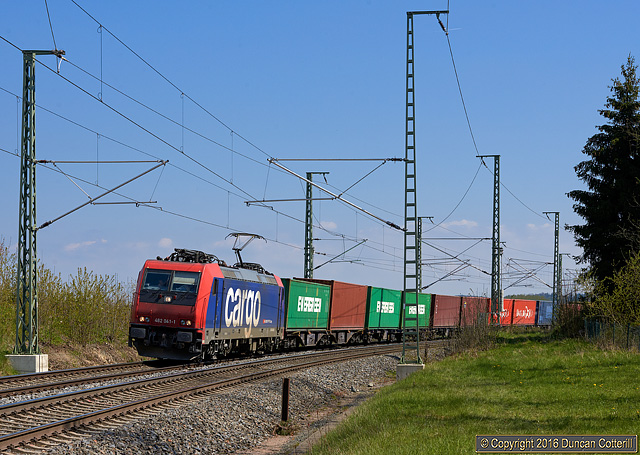
A handful of freights were seen during my short visit but I was there on a Sunday and a Monday, which should have been the quietest days of the week. A northbound container train ran on both afternoons, worked by an SBB Cargo class 482 and thought to be the same train seen twice the following week further south, hauled by a 223. DB Cargo locos also worked a freight each afternoon, one with a 145 and the other with a 185, but going in opposite directions. There was also a southbound steel train on the Monday afternoon worked by a pair of Stahlwerke Thüringen V100s.
The light was good on the Sunday morning but was becoming milky by midday and the afternoon was quite dull. Monday was almost wall to wall sunshine from start to finish, the first really good day of the trip weather wise.
Locos seen :
143.116, 143.120, 143.339, 143.566, 143.821, 143.831, 143.850, 143.875
145.039
185.074
D-SWT : 203.003, 203.013
CH-SBBC : 482.041
The light was good on the Sunday morning but was becoming milky by midday and the afternoon was quite dull. Monday was almost wall to wall sunshine from start to finish, the first really good day of the trip weather wise.
Locos seen :
143.116, 143.120, 143.339, 143.566, 143.821, 143.831, 143.850, 143.875
145.039
185.074
D-SWT : 203.003, 203.013
CH-SBBC : 482.041
A Narrow Escape
ALEX’s 183.004 was photographed south of Köfering, on the Regensburg - Landshut line, with ALX356, the 05:12 from Praha hln to München Hbf, on 8 May 2016. It only just escaped being wiped out by 183.001 going the other way with ALX 84104.The Praha - München service is an unusual international collaboration between a state operator (ČD) and an independent (ALEX), involving ALEX’s diesels running all the way to Plzeň, deep in Czech territory. The first four coaches on 183.004’s train are Czech Railways vehicles with a Restaurant/First immediately behind the loco.
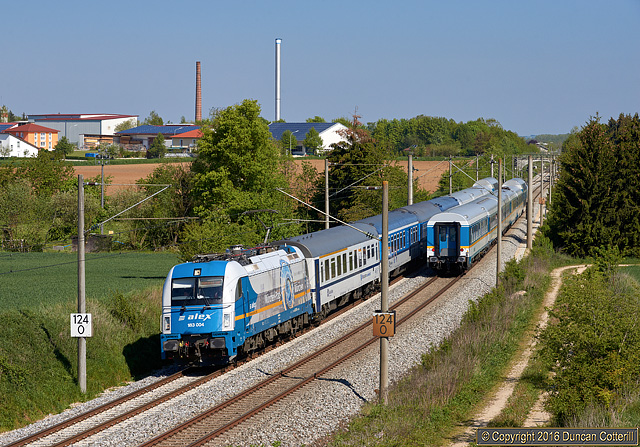
REGENSBURG - LANDSHUT
8, 12 May 2016Having done well on the Reichenbach - Hof line the previous weekend, I wanted to go somewhere different on the second Sunday of the trip. Regensburg - Landshut wasn’t too far away and I hadn’t really photographed the ALEX class 183 electrics before, so decided to give it a go. In terms of photo locations there was little to go on except Google satellite maps.
First pleasant surprise was turning up at the first potential location and finding it wasn’t a bad spot. The second was discovering that the München - Regensburg - Nürnberg REs were still worked by class 111s on push-pull sets. I’d assumed they had gone over to EMUs. The locos were on the north end of the sets, which wasn’t ideal, but still a lot better than units.
The basic passenger service consisted of an ALEX every two hours, hauled by a class 183 and linking München with Hof or Praha or sometimes with portions for both destinations. The ALEXs alternated with a two-hourly 111 powered RE to give an hourly semi-fast service. There were extra trains in the late afternoon and a couple of ALEX workings ran as two separate trains a few minutes apart, one for Hof and the other for Praha. There was also an hourly stopping passenger service worked by Agilis class 440 EMUs linking Regensburg with Neufahrn or Eggmühl. In theory these trains ran through to Ulm but as the same two units shuttled back and forth all day, they clearly weren’t going far beyond Regensburg, probably due to engineering work on the Ingolstadt line.
Freight traffic was light on the Sunday with only two freights seen in nine hours, both DB Cargo workings with a 152 and a 185 respectively. Returning to the line on my way back to the airport the following Thursday produced four freights in two hours, three DB Cargo workings and an independent.
Bayern Stalwarts
111.106 accelerated RE 4860, the 15:44 from München to Nürnberg via Regensburg, away from Ergoldsbach past Iffelkofen on the afternoon of 8 May 2016.I saw my first DB class 111s around München over 40 years ago and have always associated the class with the south-eastern corner of Germany. Until a few years ago the area was teeming with them but deliveries of new EMUs have displaced the 111s from many of their traditional duties. Fortunately they continue to operate between München and Nürnberg via Ingolstadt and via Regensburg.
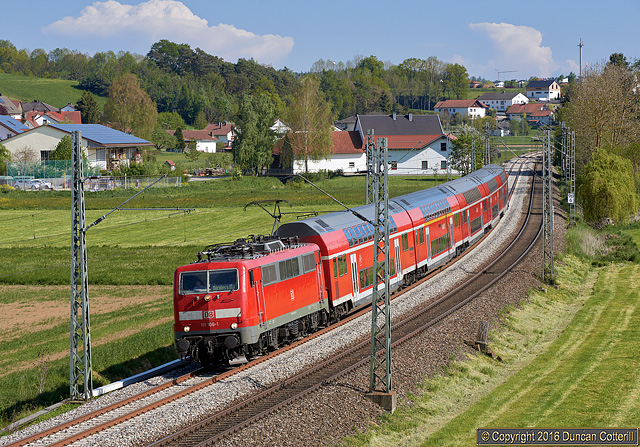
The biggest problem was the north-south direction of the line, making it difficult to find suitable spots in the middle of the day for southbound ALEXs. It was even harder for northbound ALEXs and DB Regio push-pulls in either direction. Several good locations were found for morning and late afternoon shots but it might have been a good idea to go somewhere else in the middle of the day. All five ALEX 183s were seen during the Sunday with reasonable pics of all except 183.002. It wasn’t worth getting out of the car on the Thursday, let alone trying to take pictures in the torrential rain.
Locos seen :
111.106, 111.177, 111.187, 111.202, 111.225
152.095
185.194, 185.260, 185.316
D-BBL : 214.023
D-VBG : 183.001, 183.002, 183.003, 183.004, 183.005 [ALEX]
A-LTE : 185.529
A-ÖBB : 1116.209 (dit)
Locos seen :
111.106, 111.177, 111.187, 111.202, 111.225
152.095
185.194, 185.260, 185.316
D-BBL : 214.023
D-VBG : 183.001, 183.002, 183.003, 183.004, 183.005 [ALEX]
A-LTE : 185.529
A-ÖBB : 1116.209 (dit)
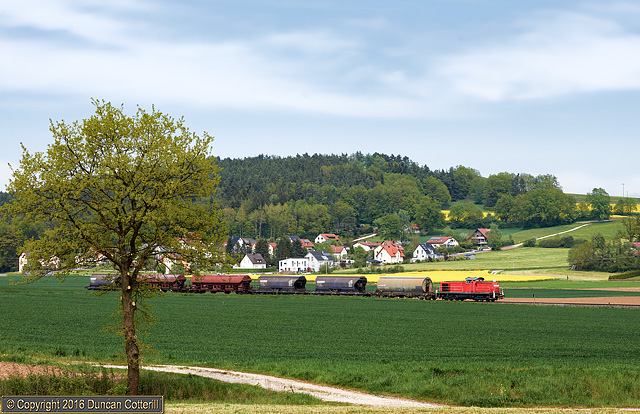
Hirschau Goods
294.647 trundled through the Bayern countryside with six loaded china clay hoppers from Hirschau on the afternoon of 11 May 2016. The hoppers were bound for Amberg and a shunt onto the back of the afternoon freight to Nürnberg Rbf.China clay or kaolin has been mined in the Hirschau area since the middle of the 19th Century and the deposits are amongst the largest in continental Europe. Annual production is somewhere in the region of half a million tonnes but much of it goes out by road.
AMBERG - SCHNAITTENBACH
9, 11, 12 May 2016This freight only branch runs north from Amberg for about 10km before turning east and running another 11km to Schnaittenbach. A number of china clay works are located close to the line on the final 3km from Hirschau to Schnaittenbach and provide the only source of traffic. Passenger services ceased in the mid 1970s.
It’s an attractive rural line and, after leaving the outskirts of Amberg, trains run along a broad valley to Gebenbach then climb steeply over a summit before dropping to Hirschau, where there’s a small yard. From Hirschau the loco takes empties to one of more of the clay works before taking loaded wagons back to Hirschau, assembling its train and returning to Amberg. In theory there are four trains a day between Amberg and Hirschau, worked by DB Cargo class 294s, one very early, one very late and two during the day. It didn’t seem to work that way in practice though.
On the first two days I visited, the morning and afternoon trains appeared to be combined into a single working. On the first day the train left Amberg around 13:00 and arrived at Hirschau about 30 minutes later. Progress was slow, particularly through Gegenbach where there are several unguarded level crossings, so it was easy to get ahead of the train for a second shot. On the second day the loco was already at Hirschau when I arrived at 13:30. On the third day I passed through Hirschau at 11:30 and found nothing in the yard or at the clay works.
On the first and second days the return working left Hirschau between 15:00 and 15:15 and took around 30 minutes to reach Amberg. In each case the consist was six loaded bogie hoppers and in each case they were seen later, attached to the rear of the afternoon Schwandorf - Nürnberg freight, due at Amberg around 16:00. The timing of the afternoon train appeared to be designed to enable this transfer. The thinking behind the timing of the morning train was less clear as the corresponding freight from Nürnberg was due through Amberg around 10:00.
Locos seen :
294.647
Hirschau Bahnhof
294.647 was about to go back to work after its lunchtime break at Hirschau on 11 May 2016.Although it hasn’t seen a regular passenger service since 1976, Hirschau station is still in use with a section of platform visible to the right and the station building and goods shed behind the loco. The three track yard is used as a base for local shunting operations and to assemble loaded china clay trains for dispatch to Amberg.
Note also the yellow auto-coupler, designed to mate with standard coupling hooks and, like the loco as a whole, capable of being controlled remotely via radio.
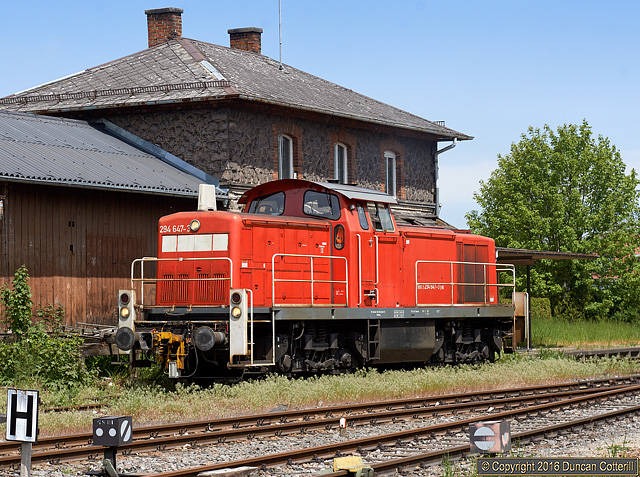
TRAVEL ARRANGEMENTS
Flights from Gatwick to München and back were with easyJet.
Local travel was by hire car booked through Holiday Autos, a Citroen C1 that looked like a jelly and drove like one as well.
Hotels were arranged through Booking.com, those for the first week were booked before leaving the UK and the remainder after being in Germany for a few days and deciding my priorities.
Hotels used were :
Gasthof zum Brunnen, Mornsheim - conveniently located for Altmühltal but only if you have a car.
Gasthof Hotel Reif, Königstein - within easy reach of the Nürnberg - Marktredwitz, Weiden and Schwandorf lines by car but nowhere near a station.
Landhotel Alt-Jocketa, Pöhl - a good base to cover the Reichenbach - Hof line and about 5 minutes walk from Jocketa station.
Hotel Bayerische Hof, Wiesau - convenient for the Marktredwitz area and only a couple of minutes walk from Wiesau station.
Königstein Hof, Königstein - as noted above for the Hotel Reif
All the hotels above were comfortable with parking, reasonably early breakfasts and free wi-fi or W-LAN (pronounced vay-lan) as it tends to be known in Germany. I’d have no hesitation about going back to any of them and my only reservation is that they all seemed to close their restaurants fairly early in the evening, fine for those on a 9 to 5 schedule but a bit restrictive when you’re trying to make the most of the available daylight. It wasn’t generally a major problem as evening freights were few and far between and getting back in time for a meal usually didn’t involve missing a shot.
The Schwandorf Job
The afternoon freight from Schwandorf to Nürnberg Rbf was a reliable performer in previous years and still seems to be dependable, usually passing Sulzbach-Rosenberg between 16:00 and 16:30 on Mondays to Fridays. There used to be a Furth im Wald to Nürnberg a couple of hours later but that doesn’t seem to run anymore.233.322 powered away from Sulzbach-Rosenberg with EK 56908 on 9 May 2016. With the climb to Neukirchen ahead and a DMU close behind, the Lokführer wasn’t hanging about.
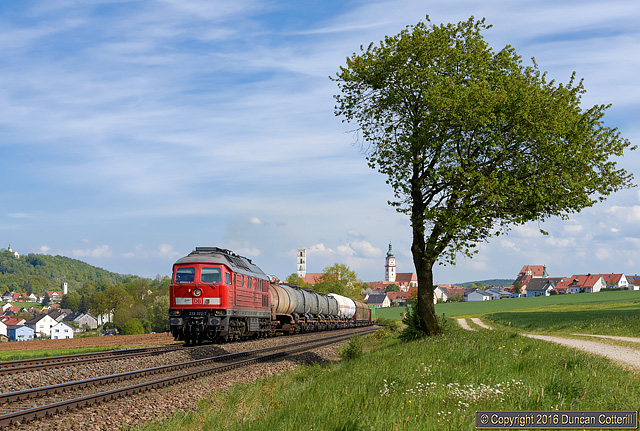
COMMENTS & CONCLUSIONS
Photographing diesel hauled freights in Europe always seems to involve a lot of hanging around and this trip was no exception. Twelve days on the various lines linking Nürnberg, Hof and Schwandorf produced fewer than 30 good pictures of freights, all but a handful of them DB Cargo workings hauled by Ludmillas. Only a couple of those were at locations I’d successfully photographed before so there were plenty of pictures in new locations. The most productive period by far was the middle week, despite it including a national public holiday on the Thursday and a “bridge day” on the Friday. There were fewer trains than usual but the weather was good and most trains ran in nice light. The weather wasn’t particularly spring like at other times and quite a few shots were lost to cloud.
Last summer’s diversions over the Marshbahn produced more good shots per day but the scenery wasn’t a patch on that in the Oberpfalz. It was the great variety of excellent locations, every bit as much as the motive power, that made it worth all the waiting. It still felt like hard work though and the endemic early running made it a lot harder to work out whether to wait for a train that might already have gone. At least it seemed fairly safe to leave 15 minutes after a train was due. If it hasn’t passed by then, it probably wasn’t coming. Thankfully the ALEX trains were more predictable and added a bit of variety.
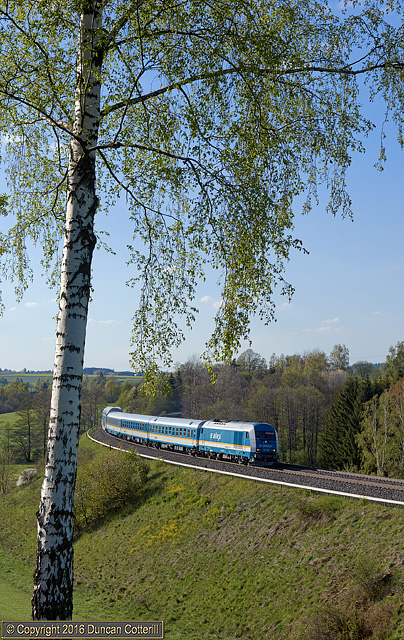
Experimental ALEX
ALEX trains were very useful for trying out shots that might not work. It was too big a risk for a freight and you never knew if or when one would show up anyway. ALEXs were more predictable and it wasn’t the end of the world if the shot didn’t work. Fortunately this one was successful.223.068 climbed away from Oberkotzau with ALX 84121, the 17:40 from Hof to München on 7 May 2016.
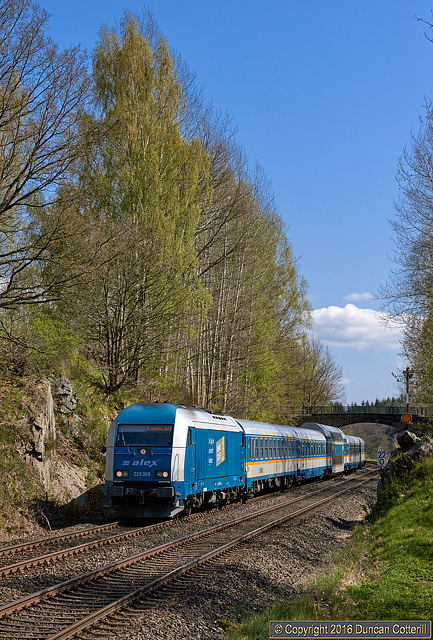
Alternative ALEX
223.069 carried an alternative livery on one side only, without the white and yellow stripes on the lower bodyside. The panel on the side advertises the Servus Ticket, €3 cheaper than the Bayern Ticket but only valid on regional routes operated by independent operators Netinera and Agilis.The loco was working ALX84111, the 09:40 from Hof to München, away from Reuth bei Erbendorf on 5 May 2016.
A German version of realtimetrains would have been a great help but it seems that most local enthusiasts rely on message boards for information about what’s running and where it is. It seems a very hit and miss way of doing things and I saw one group rush off to get a shot of an unusual light engine move, only for the loco to appear long before they could have got to their chosen spot.
In some ways the short visits to other lines were more successful than the main part of the trip. The two days on the Reichenbach - Hof line were very rewarding, as was the day on the Regensburg - Landshut line, largely due to the frequency of the loco-hauled passenger trains and co-operative weather. Even the Schnaittenbach branch, with just one train each way during the day, held its own against the diverted freights, producing four good shots in a day against an average of well under three on the main line. Only the visit to Altmühltal was a complete flop with no good shots. Most surprising were the four good shots in just over three hours on the München - Buchloe line, grabbed between spells of really foul weather.
In some ways the short visits to other lines were more successful than the main part of the trip. The two days on the Reichenbach - Hof line were very rewarding, as was the day on the Regensburg - Landshut line, largely due to the frequency of the loco-hauled passenger trains and co-operative weather. Even the Schnaittenbach branch, with just one train each way during the day, held its own against the diverted freights, producing four good shots in a day against an average of well under three on the main line. Only the visit to Altmühltal was a complete flop with no good shots. Most surprising were the four good shots in just over three hours on the München - Buchloe line, grabbed between spells of really foul weather.
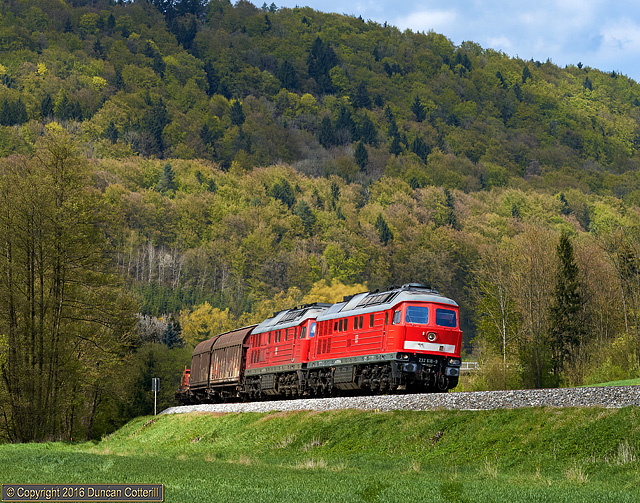
Cloud Dodging
The clouds slightly mistimed their approach on this occasion and failed to wipe out the shot completely, an unusual occurrence for the first week of the trip when most freights passed in poor light. This one only just worked and a second later the locos were in the shadow seen in the foreground.232.618 and 233.322 rolled around the curve at Alfalter in the heart of Pegnitztal with diverted southbound freight EZ 51081 on 29 April 2016.
So would I recommend a trip to the Nürnberg area to photograph the diverted freights? That depends.
It’s only really for the most dedicated, those who value one really good shot over a dozen mediocre ones and are prepared to put the effort in to get to the best locations, wait for hours, then go back and do it all again the next day because the light wasn’t quite right when the train came. Getting to the prime spots inevitably involves a fair bit of walking, even if you have a car, and a lot more if you don’t. If you want to see a lot of trains from easily accessible locations, it’s definitely not for you.
If you are prepared to make the effort then make sure you spend long enough in the area. Having to allow for trains running an hour or more ahead of schedule means that you won’t get many shots per day and, if the weather isn’t perfect, it may take several attempts to get them right.
It’s only really for the most dedicated, those who value one really good shot over a dozen mediocre ones and are prepared to put the effort in to get to the best locations, wait for hours, then go back and do it all again the next day because the light wasn’t quite right when the train came. Getting to the prime spots inevitably involves a fair bit of walking, even if you have a car, and a lot more if you don’t. If you want to see a lot of trains from easily accessible locations, it’s definitely not for you.
If you are prepared to make the effort then make sure you spend long enough in the area. Having to allow for trains running an hour or more ahead of schedule means that you won’t get many shots per day and, if the weather isn’t perfect, it may take several attempts to get them right.
